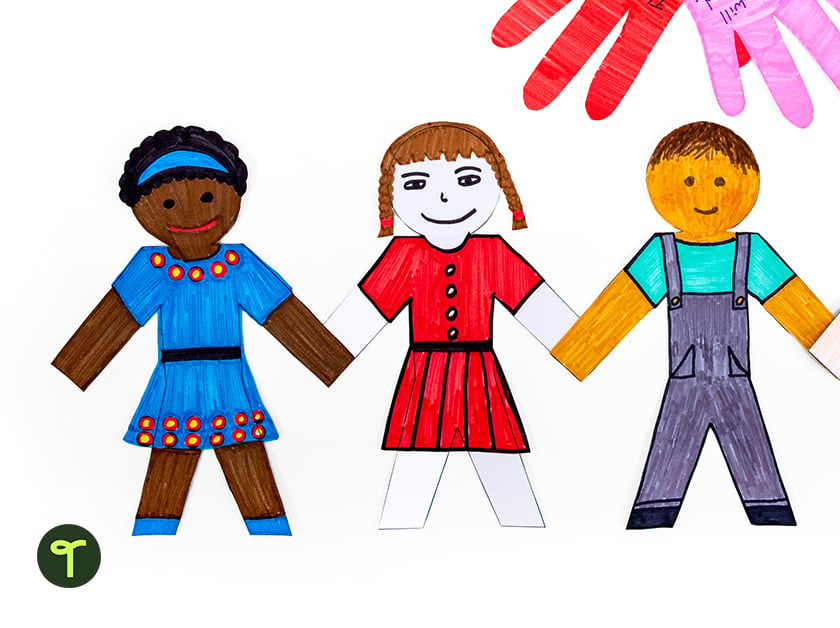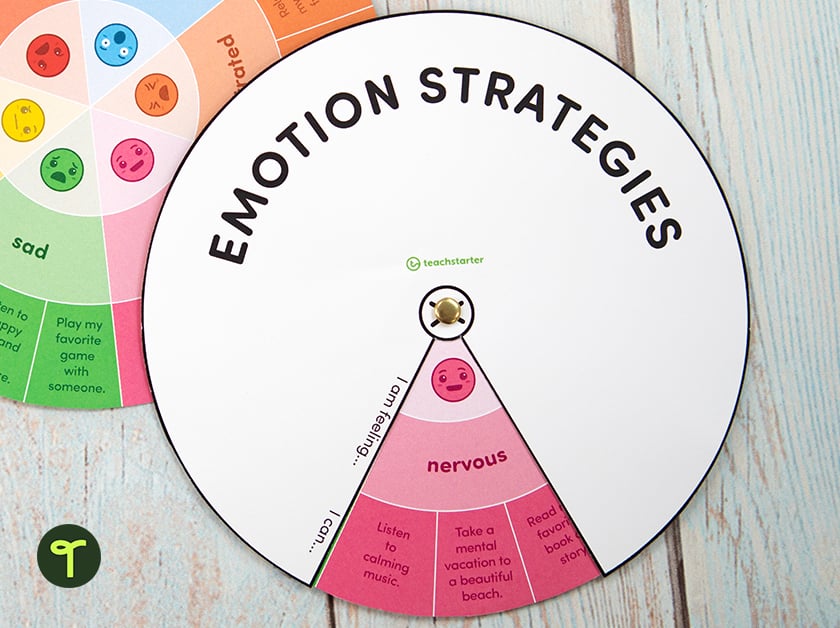Social-emotional learning (SEL) is an important part of the educational process, but it’s not always easy to find time in your schedule to help kids develop their social skills on top of all the academics you need to cover during the school year. How do you teach social skills to kids in ways that are fun and engaging? What are the best social skills activities for kids?
If you’re looking for some simple ways to incorporate social skills development into your social-emotional learning in the classroom, our teacher team has got your back. We’ve put together some of our favorite books that teach kids a variety of social skills, plus activities that you can do in the classroom to drive the lesson home.
Explore our favorite rules and expectations resources for your classroom!
Social Skills Books for Kids
The Judgmental Flower by Julia Cook
Teaching students to understand and appreciate one another’s differences is an important social skill, and one of our favorite activities starts with a reading of The Judgmental Flower with your class.
In this book by Julia Cook, a purple-petaled flower sprouts in a land dominated by Blues and finds there’s no welcome reception — just prejudice, mistrust, and a chorus of “Ewww!” Part of Cook’s series of books about building relationships, the Judgmental Flower was written by a former teacher!
Social Skills Activity Idea
After reading the book, try this social skills activity idea! Print out the diversity chain template featuring people, heart, and hand shapes. Have students start off with the people shapes, drawing in their own faces and clothing. Then provide each student with the heart shapes and have them brainstorm things that are on the inside such as; feelings, love, and thoughts. Students can then glue their heart to the back of their paper chain template and write the brainstormed words.
Join all the students together and hang up the paper chain. Lead a class discussion about how everyone looks different on the outside, however, they are all the same on the inside!
My Mouth Is a Volcano! by Julia Cook
A second social skills book for kids that our teacher team loves to use in the classroom is My Mouth Is a Volcano! Also written by Julia Cook, this children’s book is perfect for discussing classroom rules about talking and interrupting others.
Told from the perspective of Louis, a little boy who is full of thoughts that tend to erupt from his mouth, this story provides teachers with an entertaining way to teach children the valuable social skill of respecting others by listening and waiting for their turn to speak.
My Mouth Is a Volcano Activities
After reading My Mouth Is a Volcano, why not brainstorm as a class what students can do when they feel like they’re about to erupt like Louis, then have your students create their own erupting wheels?
Using four of the ideas from the class brainstorming session, students create a spinning wheel using two paper plates and a brass brad. Cut out a small quarter piece from one so that each strategy can be seen as you spin the top plate.
It’s Not My Fault! by Jory John
You may know Jory John as the author of The Good Egg and The Bad Seed, but his picture book It’s Not My Fault! is another book to add to your social skills book library. It tells the story of a little boy who refuses to take responsibility for any of his actions, so it’s packed with emotional literacy. Read it together as a class to help students make sense of the difference between whose fault something might be and whose responsibility it is. This is a great way to help children understand that they need to own up and become responsible for the choices they make!
Social Skills Activity Idea
Provide students with a scenario that can end in a blaming statement or a responsibility statement. For example:
- You didn’t finish your homework because your sister made you play PlayStation.
- Joe was being mean to you, and you pushed him!
Students then create two comic strips using this handy comic strip template. One comic will need to end in a blaming statement and the other end with a responsibility statement.
Download exit tickets to assess how much your students have learned about being a good citizen!
Ruby Finds a Worry by Tom Percival
Everyone feels fear, worry, and apprehension from time to time, and that includes our students. But how do they deal with these tough emotions? Ruby Finds a Worry follows a little girl who discovers an enormous worry … only to meet another young child who also encounters worries! This emotional intelligence adventure helps her to understand that everyone feels anxiety from time to time.
The goal of the book is to give children the tools they need to feel more in control of their anxiety.
Social Skills Activity
Follow up a reading of Ruby Finds a Worry by having students write different things that worry them on sticky notes. Using our T-chart graphic organizer, students sort their sticky notes into “worries they can control” and “worries they can’t control.”
You may also want to set up your very own classroom worry hat. When a child has found their own worry, they can write those that can’t be controlled down on a sticky note and place it in the hat.
Download emotion strategies wheels for your students!
Alexander and the Terrible, Horrible, No Good, Very Bad Day by Judith Viorst
This classic children’s book turned into a movie starring Jennifer Garner is a classic for a reason! It follows Alexander on his terrible, horrible, no good, very bad day as he wakes up with gum stuck in his hair, he drops his sweater in the sink, and oh, so much more. Reading this aldid is a great way to discuss social skills for kids around the topic of listening and paying attention to directions.
Classroom Activity Idea
After reading the book, try our social skills story template – Being a Good Listener. Talk with your students about what is happening in each picture. Students can role play being a good listener, then cut and sort the template in the correct order!
The Book of Rules by Brian Gehrlein
Learning to follow rules is an important social skill for kids, and The Book of Rules is a great storybook for teachers who are searching for a fun and engaging way to help explain the importance of setting rules in the school environment.
Rule breakers better beware! If they don’t follow the rules, Dennis the monster will eat you! This silly book presents a tough concept for students in a way that will bring out the giggles and set you up for an important discussion.
Social Skills Activity Idea
Look at your own classroom rules, discuss the importance of them, and ask the students to brainstorm what would happen if each of the rules didn’t apply to them! As a class, decide on a fair reward and consequence for each rule.
A Bad Case of Tattle Tongue by Julia Cook
Yes, it’s another Julia Cook book! This beautifully designed children’s book teaches children the difference between tattling and telling. No one likes ‘Josh the Tattler’ because he tattles way too much. But one night Josh wakes up to find that his tongue is very long, yellow, and covered in bright purple spots! Will a bad case of tattle tongue teach him a lesson?
A Bad Case of Tattle Tongue Activity
After reading A Bad Case of Tattle Tongue, create a classroom tattle monster. Kids love it, and it still allows students to voice their concerns.
You may also want to display our Before You Tell the Teacher, Ask Yourself… Poster and have your students complete our Tattling vs Reporting Sorting Activity.
How to Hug a Pufferfish by Ellie Peterson
This is a fantastic story teaching children about personal space and respecting our peers’ boundaries. Set under the sea, How to Hug a Pufferfish follows the story of underwater friends who learn to ask a pufferfish’s permission before giving him a hug.
Social Skills Activity
For this social skills activity, you might want to head outside or see if the gymnasium is open for use. The goal is to play a game of tag with a twist! Students must hold a hula hoop around them as they run. The person who is ‘It’ tries to bump their hula hoop into the other students’ hula hoops. If they bump anyone, that person is ‘It’!
Also, explain that if any player bumps another player’s hoop accidentally during the game, their bubble “pops,” and they are out. They must drop their hoop onto the ground and sit down inside! The goal is to help students develop an awareness of where their bodies begin and end, as well as an awareness of those around them.
Discussing social skills? Explore hundreds of social and emotional learning resources created by teachers around the country!
Banner image via Shutterstock/Monkey Business Images









Comments